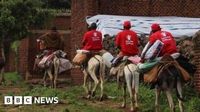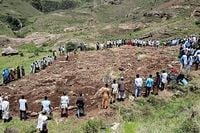In the remote village of Tarasin, nestled within Sudan’s Marrah Mountains, a catastrophe of staggering proportions has unfolded. On August 31, 2025, after days of relentless rainfall, a massive landslide tore through the community, burying homes, schools, and entire families beneath a torrent of mud and rock. The disaster, which struck one of the most isolated regions of Darfur, has left the world reeling—and desperate for answers and aid.
By September 4, Sudanese authorities had recovered and buried 375 bodies, but the grim task is far from over. Many more remain trapped beneath the debris, and the true death toll may never be fully known. Mohamed Abdel-Rahman al-Nair, spokesperson for the Sudan Liberation Movement-Army (SLM/A), estimated that as many as 1,000 people could have perished, a figure echoed by the United Nations Office for the Coordination of Humanitarian Affairs (OCHA). Save the Children, a prominent aid group working on the ground, reported that about 200 children are among the dead, underscoring the tragedy’s devastating impact on the youngest and most vulnerable.
Francesco Lanino, operations director for Save the Children in Sudan, painted a harrowing picture of the aftermath. “This is a tragedy within a tragedy that is the current conflict in Sudan. This is one of the worst natural disasters that has happened in Sudan,” Lanino told the Associated Press. He described arriving in Tarasin and finding “almost half of the mountain had collapsed on the village at its bottom.” Survivors recounted that the landslide struck in two waves—the first on Sunday afternoon, followed by a second a few hours later, which hit nearby villages and those attempting to help after the initial collapse.
Rescue operations have been fraught with difficulty. The Marrah Mountains, rising to more than 3,000 meters (9,840 feet), are not only remote but also largely cut off from modern communications. Roads have been destroyed by the ongoing rains and flash floods, forcing aid workers to travel by donkey and camel over treacherous, muddy paths. “Families in [Tarseen] have lost everything. It took our team more than a full day on a rocky, muddy, and hilly route to reach this devastated community,” Lanino explained in a statement to BBC News.
The logistical challenges have made it nearly impossible to confirm the full scale of the disaster. According to BBC Verify, satellite imagery shows at least seven buildings washed away at the convergence of two mudflows, with large swathes of the village completely obliterated. Local leaders, such as Ibrahim Suleiman of Daramo locality, described the desperate efforts: “We recovered 370 bodies and buried them. Others are still trapped under the rocks and some were carried away by floodwaters.” The SLM/A, which controls the area, has called for urgent intervention, labeling the situation as “catastrophic.”
The landslide has displaced at least 150 people from Tarasin and neighboring villages, according to the International Organization for Migration (IOM). These families now shelter in nearby communities, many having lost every possession. Aid organizations, including Save the Children and World Vision, are racing to deliver food, water, medical supplies, and tarpaulins. On September 5, an emergency team of 11 staff—including medical professionals, child protection experts, and mental health workers—made the arduous journey by donkey to distribute supplies and provide immediate care.
Mobile health clinics and emergency medical teams have been deployed to the scene, with the UN and other partners preparing to send additional resources as needs continue to mount. The goal, according to OCHA, is to deliver essential aid for up to 750 people, including medical kits and food. “With hundreds of lives lost and communities shattered, we are racing against time and immense challenges to reach the most vulnerable,” said Simon Mane, World Vision’s national director for Sudan, in a statement to BBC News. He described the situation as a “tragedy of unimaginable scale.”
For survivors, the ordeal is far from over. As of September 5, Save the Children reported that 150 people, including 40 children, were receiving medical treatment. The group is also working to relocate survivors to safer areas, using camels and donkeys due to the impassable roads. The psychological toll is immense, with entire families wiped out and communities left in mourning. “Think about a village with all its existing schools and health facilities totally under the mud, and half of the mountain collapsed all over the village which is fully covered so there is nothing left of the existing structure,” Lanino told the Associated Press.
The disaster has unfolded against the backdrop of Sudan’s ongoing civil war, which erupted in April 2023 and has since plunged the nation into one of the world’s worst humanitarian crises. The conflict between the Sudanese army and the paramilitary Rapid Support Forces has killed more than 40,000 people and displaced as many as 12 million. The Marrah Mountains, where the landslide occurred, had become a refuge for those fleeing violence elsewhere—only to face a new and unexpected calamity.
The civil war has severely hampered rescue and relief efforts. The SLM/A, which has remained neutral in the conflict, controls the affected area, while heavy rains and flash floods have made access even more challenging. Aid organizations warn that the disaster compounds an already dire situation: more than 30 million people across Sudan are in need of humanitarian assistance, and at least 21 areas have been recently affected by heavy rains and floods, raising fears of disease outbreaks.
Satellite images reviewed by BBC Verify reveal the extent of the devastation, showing freshly dug graves and the disappearance of entire settlements at the foot of the mountain. The presumed burial sites, dug in the days after the landslide, hint at the overwhelming number of lives lost. Yet, as aid workers continue their grim search, the full human cost remains uncertain.
International response has been swift but limited by the region’s inaccessibility. The United Nations and its partners have mobilized rapid assessment missions, while local NGOs and international groups have joined forces to deliver aid. Still, the needs are immense, and calls for a broader international response grow louder. “The landslide caused a ‘catastrophic humanitarian situation’ that requires a rapid response from the international community to provide food and shelter for those who have lost everything,” al-Nair emphasized in a statement.
As Tarasin and its neighbors struggle to recover, the disaster serves as a sobering reminder of the fragility of life in Sudan’s conflict-ridden heartland. With the rainy season expected to continue into September and the threat of further landslides and disease looming, the road to recovery will be long and fraught with difficulty. For now, the people of Tarasin must rely on the determination of aid workers and the compassion of a watching world.
In the shadow of the Marrah Mountains, hope is hard-won. But even as tragedy compounds tragedy, the resilience of Sudan’s people and the solidarity of those who rush to their aid shine through the darkness, offering a glimmer of light in an otherwise bleak landscape.

